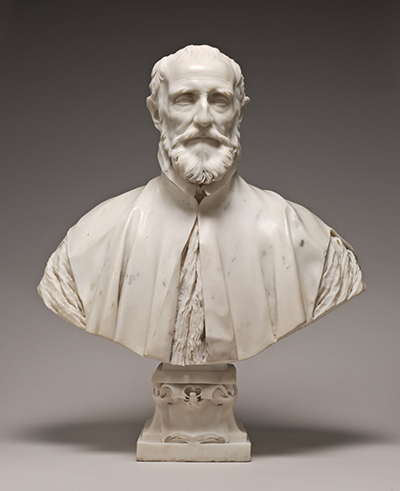Completed in 1626, Bust of Francesco Barberini by Gian Lorenzo Bernini is a portrait showcasing Monsignor Francesco Barberini (1528-1600). He was a learned man who served in various positions in the church and was influential.
He mentored Maffeo Barberini who later became Pope Urban VIII. The bust was created by Bernini to honour this great man. So, it showcases his head carved to represent his portrait.
Bernini polished the face finely to hint at the bloom of flesh and grizzled the hair slightly utilising roughness of a fine-toothed chisel. Gian Lorenzo then darkened the beard through the use of deep recesses. This will make the viewer imagine a tinge of blue from below the eye. He formed a hollow below the eyes to create the bluish colour people have in their eyes. All the same, Gian Lorenzo got the chance to show his genius through an intricate treatment of the shirt, pleated vest with zigzag patterns and deeply undercut collar. This bust stands out as the most brilliant portraits made by the artist, but it was carved from another portrait indicated by the remoteness that is unlike Gian Lorenzo's works.
Bust of Francesco Barberini by Gian Lorenzo Bernini employs the Roman tradition of ancestral portraiture. In this bust, Bernini included most of the chest and carved truncation to show the shoulders as a way of imposing the physical bulk. The material used in this painting is marble which diminishes the contrast of the eyes, flesh and eyebrows enabling viewers to identify a face. Gian Lorenzo Bernini carved the marble magnificently to render various textures and form subtle shadows so convincingly, thereby, enabling him to create a range of colours.
Due to the immense role played by Francesco Barberini in Pope Urban VIII's life, he instructed Gian Lorenzo Bernini to create several busts as a remembrance for his family members. This work was commissioned by him to commemorate the death of his revered uncle. The request was honoured since his uncle previously held a position of authority in the church. Francesco Barberini served as an apostolic protonotary. In 1961, the sculpture was handed to the National Gallery of Art in Washington D.C. via the Kress Collection donation. In 1950, the Kress Foundation acquired the sculpture from Court Alessandro Contini-Bonacossi with 25 other paintings.
The portrait was completed after the death of Francesco Barberini, so he had to base it on an existing painting. This existing painting is part of the Corsini Collection in Florence. It served as an inspiration for him because the character he wanted to depict was already dead by the time he began the painting. As a result, Gian Lorenzo made good use of the design, but notable differences between the painting and the bust are the exclusion of the three-quarter part of the body.




